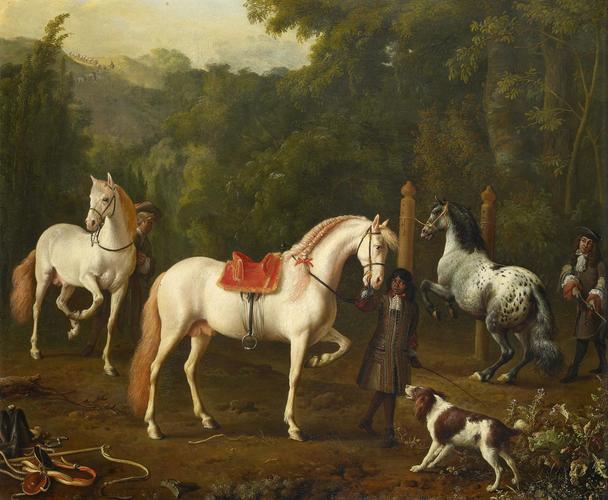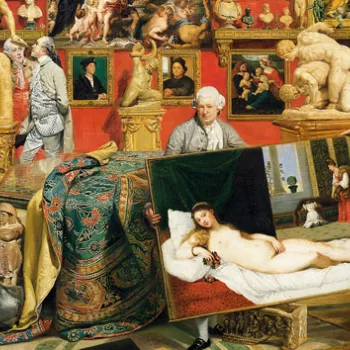A Groom Assisting a Riding Master at the Manège 1686-87
Oil on canvas | 80.6 x 97.1 cm (support, canvas/panel/stretcher external) | RCIN 405957
-
Nijenrode Castle near Utrecht was begun in the middle of the fourteenth century and considerably enlarged in the early years of the seventeenth. It was destroyed during the French invasion of 1672, and rebuilt, complete with moat by the Amsterdam merchant, Johan Ortt (1642-1701), when he acquired it in 1673. Ortt became Lord of the Manor of Nijenrode in 1675. The Utrecht historian Cornelis Booth recounted that as well as restoring the castle, Johann Ortt ‘built a riding school and stables to the right of the house, capable of holding up to fifty horses, of which he was a great lover. Of horses he had an incomparable collection, not only measured against others in the county of Utrecht, but possibly in the whole Netherlands. Magnificent riding and coaching horses were raised in his own stud.’
This is one of three depictions of the castle, its stud and its owner by de Hondecoeter (RCIN 405954-6). This scene depicts Spanish horses undergoing training in an imaginary landscape, one saddled in the Spanish fashion and held by a black servant boy in livery, another taught the Levade by the riding master, dressed as a nobleman and holding a schooling whip. This horse is held between two pillars by a rope attached to its bit. A pile of equipment lies in the foreground - saddle, whip, blinkers and scraper. A string of horses are exercised on the hill behind.
There is a parallel between Ortt’s equestrian interests and those of William Cavendish, Duke of Newcastle (1592-1676), who built great riding stables at Welbeck in 1625. When Cavendish was exiled in Antwerp during the Commonwealth, he published his Méthode et invention nouvelle de dresser les chevaux (Antwerp 1658), with illustrations after drawings by Abraham van Diepenbeeck. These have exactly the same mix of favourite horse, trusty stable hands, brand new stable block and ancient vernacular castle as we see in de Hondecoeter’s works and are a further example of the close connection between the Dutch and English aristocracy, on the eve of the ‘Dutch invasion’ of 1688. One of the Dutch noblemen who accompanied William of Orange to England was Willem Bentinck (1649-1709). Stubbs’s image of the riding stables at Welbeck, painted in 1767 depicts William Henry Cavendish Bentinck, 3rd Duke of Portland (1738-1809). Stubbs may even have known these paintings by de Hondecoeter, which were brought to England by Mary Doublet of Groeneveldt (c.1702-1801), who married Robert Darcy, 4th Earl of Holderness (1718-78) in 1743 and lived at Sion Hill. The Earl of Holderness was also tutor to George III’s eldest sons, Princes George and Frederick, in 1771-6; it is conceivable that as a child George IV saw these three paintings that he was to acquire as a man. He then took them to King’s Lodge in Windsor Park in 1822, along with his collection of works by George Stubbs, though whether or not they were hung together cannot be determined.
Signed: 'M D Hondecoeter'Provenance
Acquired by George IV between 1802 and 1806; recorded at Warwick House in 1816 (no 497) and 1819 (no 533, valued at 25 guineas); taken to the King's Lodge in Windsor Park in 1822
-
Creator(s)
Acquirer(s)
-
Medium and techniques
Oil on canvas
Measurements
80.6 x 97.1 cm (support, canvas/panel/stretcher external)
102.8 x 118.0 x 10.9 cm (frame, external)
Category
Object type(s)
Other number(s)









